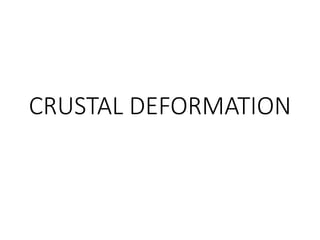Report
Share

Recommended
More Related Content
Similar to ppt-in-geology1.pptx
Similar to ppt-in-geology1.pptx (20)
Concept of rock deformation and tectonics( Khan A.A)

Concept of rock deformation and tectonics( Khan A.A)
Earthquake Engineering Earthquake and Ground Motion

Earthquake Engineering Earthquake and Ground Motion
More from HazelValderama1
More from HazelValderama1 (6)
Recently uploaded
Recently uploaded (20)
Pests of mustard_Identification_Management_Dr.UPR.pdf

Pests of mustard_Identification_Management_Dr.UPR.pdf
Recombinant DNA technology (Immunological screening)

Recombinant DNA technology (Immunological screening)
Disentangling the origin of chemical differences using GHOST

Disentangling the origin of chemical differences using GHOST
Raman spectroscopy.pptx M Pharm, M Sc, Advanced Spectral Analysis

Raman spectroscopy.pptx M Pharm, M Sc, Advanced Spectral Analysis
Labelling Requirements and Label Claims for Dietary Supplements and Recommend...

Labelling Requirements and Label Claims for Dietary Supplements and Recommend...
Forensic Biology & Its biological significance.pdf

Forensic Biology & Its biological significance.pdf
Hubble Asteroid Hunter III. Physical properties of newly found asteroids

Hubble Asteroid Hunter III. Physical properties of newly found asteroids
VIRUSES structure and classification ppt by Dr.Prince C P

VIRUSES structure and classification ppt by Dr.Prince C P
ppt-in-geology1.pptx
- 2. • Crustal Deformation • Crustal deformation refers to the changes in the shape and structure of the Earth's crust due to the application of stress over time. This process is primarily driven by tectonic forces and can result in various geological features and phenomena. Crustal deformation can manifest in several ways, including: • 1. **Folding:** When rocks are subjected to compressional forces, they may fold, forming anticlines (upward arches) and synclines (downward troughs). These folded rock layers are common in mountain ranges. • 2. **Faulting:** Faults are fractures in the Earth's crust along which movement has occurred. They can be caused by horizontal compression (reverse fault), horizontal extension (normal fault), or horizontal shear (strike-slip fault). • 3. **Uplift:** Crustal deformation can lead to the uplift of land, resulting in the formation of mountain ranges and plateaus. This uplift occurs when tectonic plates collide, pushing the crust upwards. • 4. **Subsidence:** Conversely, crustal deformation can also cause subsidence, where the Earth's crust sinks or settles due to various factors, such as the cooling and contracting of the Earth's interior. • 5. **Isostasy:** Isostatic rebound is a form of crustal deformation that occurs when the Earth's crust adjusts its elevation in response to changes in the distribution of weight on its surface. For example, after a glacier melts, the land that was previously depressed by the weight of the ice may gradually rise back to its original position. • Crustal deformation is a fundamental process in the field of geology and is crucial for understanding the Earth's dynamic nature, the formation of geological features, and the study of earthquakes and plate tectonics.
- 3. Mountain Building • Mountain building, also known as orogenesis, is a geological process that leads to the formation of mountain ranges. It is primarily driven by the movement and interaction of Earth's tectonic plates. Here are the key processes involved in mountain building: • 1. **Tectonic Plate Collision:** The most common scenario for mountain building occurs when two tectonic plates converge or collide. There are several types of plate boundaries where this can happen, including convergent plate boundaries, where plates move towards each other. • 2. **Compression:** As tectonic plates collide, immense pressure and stress are generated. This compression of the Earth's crust can cause rocks to fold, fault, and fracture. • 3. **Folding:** Rocks in the crust can fold under the intense pressure, forming anticlines (upward-arching folds) and synclines (downward-arching folds). These folded rock layers are characteristic of mountain ranges. • 4. **Faulting:** Along with folding, faulting is common in mountain-building regions. Faults are fractures in the Earth's crust along which movement occurs. Reverse faults, where rocks are pushed upward, are typical in compressional mountain-building zones. • 5. **Uplift:** The intense compressional forces can lead to the uplift of large blocks of the Earth's crust. This uplift is what ultimately results in the formation of mountains. Over millions of years, mountains can rise to great heights. • 6. **Erosion:** While mountain-building processes create mountains, erosion continually wears them down. This includes processes like weathering, sediment transport, and glacial activity. The balance between uplift and erosion determines the height and longevity of mountain ranges. • Mountain ranges are diverse and can vary greatly in terms of their age, height, and geological characteristics. Some famous examples of mountain ranges formed through the process of mountain building include the Himalayas, the Rocky Mountains, and the Andes. These geological features play a crucial role in shaping landscapes, climate patterns, and ecosystems on Earth.